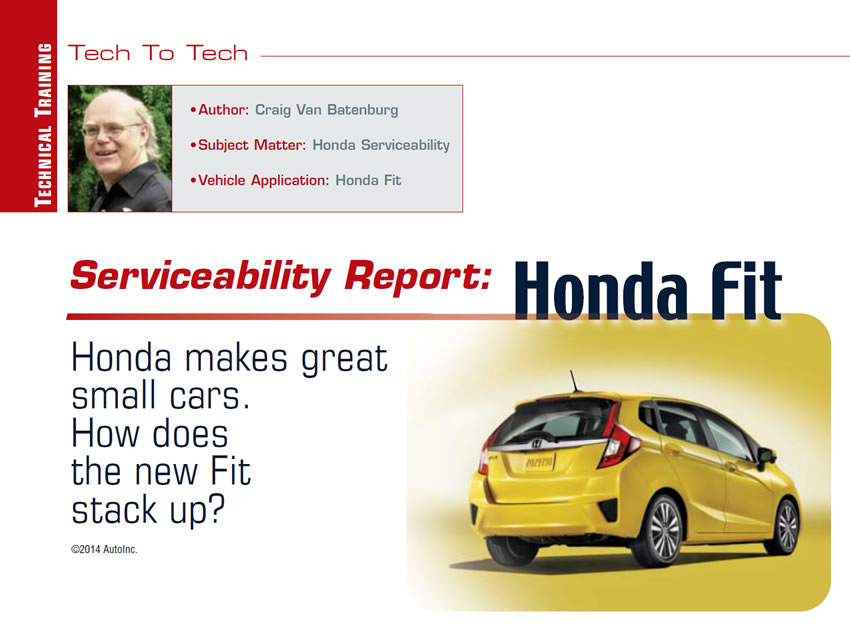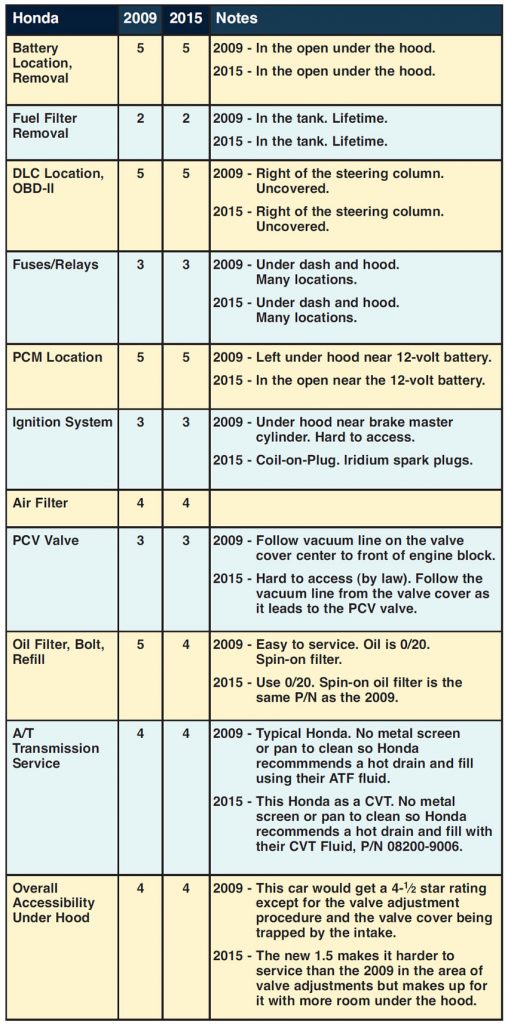
Tech to Tech
- Author: Craig Van Batenburg
- Subject Matter: Honda Servicability
- Vehicle Application: Honda Fit
Honda makes great small cars. How does the new Fit stack up?
Hondas are a favorite of mine. So being critical of Honda is not easy for me.
This month, we will examine the 2015 Honda Fit and see what happened when it was redesigned recently. The Fit went on sale in the U.S. on April 20, 2006 as a 2007 model-year car. The first-generation Fit was replaced after only two model years by a new 2009 model and again in 2014 as a 2015 model. We will compare a 2009 to the new 2015.
2009 Honda Fit
The 2007 Fit was inexpensive to buy and easy to maintain, had utility and interior room to rival the Civic and was fun to drive. It won a place on the 10 Best Cars list with Car and Driver magazine.
Just two-and-a-half years into the Fit’s North American product cycle, a newer Fit was introduced. Why? The Jazz, as the Fit is called in many other countries, had been out for a few years prior to coming to America and it was due for a change. A car company cannot make money redesigning a vehicle every two or three years, but the Jazz was more than five years old in 2008.
The 2009 model-year Fit had a wheelbase of 98.4 inches, a length of 161.6 inches, width of 66.7 inches and a height of 60 inches. Use of high-tensile steel in the unit body was added for safety and an increase in front-end rigidity of 164 percent. More size usually means more weight, and that’s true here. The Fit weighs 2,506 pounds. It was fitted with electric power steering that was light and quick (2.5 turns lock-to-lock). The sport model came with a set of Bridgestone Turanza 185/55 all-season tires on 16-inch aluminum wheels.
The engine had a displacement of 1497cc, intake-valve timing was i-VTEC (as you may know, a unique Honda system worthy of more study), intake valves were 28 millimeters and the pistons had a skirt-coating process designed for oil retention. It produced 117 horsepower at 6,600 rpm and 106 pound-feet at 4,800 rpm that made the right amount of power for a small car.
The 2009 Fit will do zero to 60 mph in 8.5 seconds and the quarter-mile in 16.6 seconds at 83 mph. A taller fifth-gear ratio was for fuel economy. The driveline was either a five-speed automatic or a five-speed manual shift. Both worked well.
The interior volume with the rear seatbacks folded flat was 57.3 cubic feet. A long wheelbase allowed Honda to create more rear-seat legroom than usual in a car that size and, in turn, made it possible to flop the seatbacks forward and flat regardless of the front-seat position, something accomplished with a single flip of a lever. The rear compartment also benefits from a 10.6-gallon fuel tank that is placed under the front seats, not inside the car but under the floorboard.

There was one safety recall that required the valve train to be removed and faulty springs replaced on some models. Look up Honda TSD No. 11-010 for “lost motion springs” and that document will explain more.
This car sold well and most service was simple. Honda owners tend to take their car maintenance seriously so the shops that service them will get regular visits. Keep 0/20 oil on the shelf for oil changes, and I recommend a valve clearance adjustment done on a cold engine every 60,000 miles (more than Honda says).

2015 Honda Fit
The 2015 Fit got a new platform, new engine and transmissions, and a more modern exterior. It looks larger than the previous model but is actually 1.6 inches shorter. It keeps the same height and is 0.3 inch wider. It is more substantial, but weighs 100 pounds more. With different trim levels, it tips the scales at 2,600 to 2,700 pounds. Honda is using more high-strength steel in this new Fit, which means that, in spite of the increase in curb weight, the Fit gains in rigidity in many areas.
Safety
The 2014 model-year was skipped except for a limited number of plug-in Fit EVs. Two small overlap front tests of the 2015 Fit were conducted. In the first test, the bumper beam (a steel bar located behind the plastic bumper cover) broke free of the frame rail on the passenger side of the car early in the crash. This caused much more of the crash energy to be absorbed by the driver side than Honda intended, resulting in extensive intrusion into the driver survival space and excessive upward movement of the steering column.
As a result, Honda improved the strength of the bumper beam welds for all Fits built after June 2014 and announced a “product update” to replace the beams free of charge on cars built before the change was made on the assembly line.
In the second test of a car built with the improved bumper beam, intrusion was considerably reduced and the steering column remained much more stable during the crash. Only cars with the replacement bumper beam earn the Acceptable rating in the small overlap test and qualify for the TOP SAFETY PICK designation by the Insurance Institute for Highway Safety.
Drivetrain
The 1.5 liter four-cylinder is all new. Complete with direct injection and dual overhead cams (whereas before it had port injection and one camshaft) in addition to i-VTEC’s dual-profile cams, the 1.5 uses variable timing control. The new system will retard cam timing at low rpm and advance it at high engine speeds. There are oil jets to cool the underside of the pistons and a crankshaft that has been lightened by 27 percent through a 50 percent reduction in counterweights, from eight to four. An additional 13 horsepower and 8 lb-ft of torque, for totals of 130 and 114, respectively, that added more power as the weight went up some. EPA fuel-economy estimates range from 29 mpg city and 37 highway with the six-speed manual to 33/41 with the CVT (Constantly Variable Transmission). It really is better to never shift.
Like the engine, both of the Fit’s transmissions were redesigned. For those who still like to shift, it means a sixth gear. For automatic buyers, it now has a CVT.
The redesign for technicians was a “wash” with more room under the hood but a twin cam for more work at tuneup time.

My trip to Honda R & D in Raymond, Ohio
For three days in August of 2014 I was sworn to secrecy as I was working with Honda R&D, but I can tell my impression of research and development companies in general as I have worked at many as a consultant.
First, service and repair access is not No. 1 on the list of things to do. Deadlines are always present and years of lead time can change if the market demands it. When I talk to engineers, they express interest in service and repair access, but I also hear stories about changes that are made in the development stage that were not planned for. My stubborn Dutch heritage still wonders why more isn’t done to make access easier than it is.
Smarter designs decrease warranty costs, so those ideas are the most listened to when I bring up this subject. It is always about the “bottom line.” Soichiro Honda, the founder of Honda Motor Company, was rumored to have said back in the 1950s, “If we [Honda] made motorcycles easier to fix [read more intelligently designed] then the better [read smarter] mechanics would work on our Hondas instead of the other motorcycles.” If he didn’t say it, it did work out that way. As a motorcycle mechanic in the 1960s, the best motorcycles I knew were Hondas. Why work on machines that make an oily mess, with new parts that don’t fit well? Smart designs are enjoyed by the most knowledgeable technicians.
2009 summary
Honda has made great cars since the 1980s but lost some of the technical advantage in the last decade as other OEMs caught up to them.
The Fit was so good it took sales away from the Civic in Japan and made fans everywhere. Technicians I spoke to love the old and new Fit – simple and easy to repair. The only real complaint I have is the valve clearance adjustment has been pushed to the back burner.
Honda has a great engine and is one of the few companies that still design valve trains that are unique and well-conceived, but when the marketing team gets ahold of the preventive maintenance recommendations, the science of metallurgy is denied. The only time a Honda service department will recommend that a feeler blade be inserted between the follower and the camshaft lobe is when the valves are noisy. What does a tight valve sound like?
2015 summary
The new Fit has been redesigned to keep up with the rest of the pack but did not move ahead in any big way. Now that higher CAFE standards are here in America and CO2 regulations are in place elsewhere, the car designers have the incentives to think creatively to meet these goals. The new Fit is not a problem for technicians, but could things get better? The answer is always “yes”. There was a time when Honda was “King” in serviceability. Those days seem to be over.

Craig Van Batenburg, AAM, is a master hybrid technician. He was the owner and lead technician for more than 25 years at his own shop that specialized in Honda and Toyota vehicles. Van Batenburg was the president of ASA Massachusetts from 1993 to 1996. He is owner of the Automotive Career Development Center (ACDC), which he founded in 1998. He develops technical classes for those who require updating their knowledge in hybrid and electric cars. Some of his customers include the U.S. Army, U.S. Marines, Delphi, Midtronics, John Deere, Porsche of America and BG Products. You can reach Van Batenburg at [email protected].
This copyrighted article is reprinted with the permission of AutoInc., the official publication of the Automotive Service Association (ASA). To learn more about ASA and its commitment to independent automotive-service and repair professionals, visit www.ASAshop.org or call 800-272-7467.













